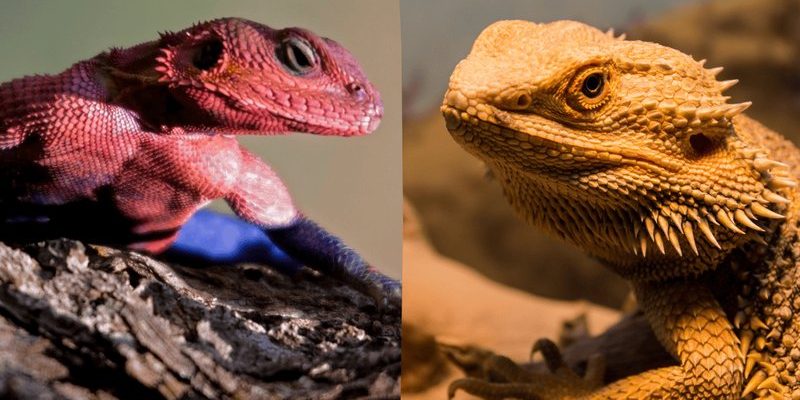![Bearded Dragon Vs. [Similar Species] - How They Compare](https://gudri.com/wp-content/uploads/2025/06/Bearded_Dragon_Vs___Similar_Species____How_They_Compare_image_0.jpg)
Let’s dive into this comparison to see how a bearded dragon stacks up against a few of its similar species! We’ll explore their habitats, temperaments, care needs, and even a few fun facts along the way. So, grab your favorite drink, and let’s chat about these captivating reptiles!
Physical Appearance
One of the first things you’ll notice about bearded dragons is their distinct look. They have a broad head, spiky beard, and a robust body. Typically, they grow to about 18 to 24 inches long, which makes them a decent size for a pet. Their colors range from earthy browns and yellows to vibrant oranges, making them visually stunning.
Now, let’s compare that to leopard geckos, who are a lot smaller—usually around 7 to 10 inches long. They have a more slender build and a unique spotted pattern that resembles a leopard’s coat. Another similar species, the blue-tongued skink, gets a bit larger, averaging 18 inches. They have smooth, shiny scales and, as their name suggests, bright blue tongues which they display when threatened.
So, if you’re looking for a larger and more interactive reptile, a bearded dragon might be your best bet. But if space is a concern, or you prefer a smaller companion, a leopard gecko could be right up your alley!
Temperament and Behavior
Bearded dragons are often dubbed as the “puppies of the reptile world.” They’re known for their friendly and sociable nature. You might find them enjoying your company, basking in the sun, or even climbing onto your shoulder as you lounge around. Honestly, they love interaction and can even be trained to recognize their owners.
On the other hand, leopard geckos are a bit more on the shy side. They’re nocturnal and prefer to come out at night, often hiding during the day. They might not be as cuddly as bearded dragons, but they’re still great pets. Plus, leopard geckos can be less demanding in terms of interaction compared to their bearded counterparts.
When we take a peek at blue-tongued skinks, these guys are more curious and can show a variety of personalities. They can be friendly, too, but typically require a little more handling to get used to humans. Overall, if you’re after a social critter that loves to hang out, the bearded dragon is a top choice!
Habitat and Setup Needs
Creating a cozy home for your lizard is crucial. Bearded dragons thrive in a larger enclosure—a minimum of 40 gallons is ideal for adults. They need a basking spot with a heat lamp to keep them warm during the day, along with some cool areas for when they want to chill out.
Leopard geckos, in contrast, can live comfortably in a smaller setup. A 20-gallon tank works well for them. They also require a heat source, but it’s usually a little less demanding than for bearded dragons. Their habitat can be decorated with caves and soft substrate, allowing them to hide and feel secure.
For blue-tongued skinks, they need a bit more floor space since they love to roam. A setup of at least 40 gallons is recommended, with plenty of room for climbing and hiding. They also enjoy a good mix of heat and cool spots, similar to bearded dragons. When it comes to habitat, consider what’s best for both your space and your future pet’s comfort.
Dietary Needs
When feeding your bearded dragon, diversity is key! They enjoy a mix of vegetables, fruits, and live insects like crickets and mealworms. Young dragons require more protein, while adults need more greens. This balanced diet is important for their development and overall health.
Leopard geckos have a simpler diet. They primarily eat insects like crickets and mealworms, similar to bearded dragons, but they don’t need vegetables. However, they can snack occasionally on small amounts of fruits. It’s a bit easier if you’re not ready to deal with a varied diet.
Blue-tongued skinks are kind of the middle ground. They eat a mix of insects, fruits, and veggies, making their diet a bit more complex than leopard geckos but simpler than bearded dragons. You might want to get a variety of food ready if you choose to care for a skink!
Health Considerations
Like any pet, it’s crucial to be aware of potential health issues. Bearded dragons can sometimes suffer from metabolic bone disease if they don’t get enough calcium and UV light. Regular vet check-ups can help catch any problems early.
Leopard geckos, while generally hardy, can get impacted if they don’t eat properly or if their environment isn’t right. Keeping their habitat clean and ensuring they have the right conditions can help prevent health problems.
Blue-tongued skinks are also prone to some health issues, like respiratory infections if they’re kept in a poorly ventilated space. As with any pet, regular care and attention can go a long way in ensuring they stay healthy and happy.
Which One is Right for You?
Choosing between a bearded dragon, leopard gecko, or blue-tongued skink really boils down to your personal preferences and lifestyle. Are you looking for a sociable pet that enjoys interaction? Then a bearded dragon is a fantastic choice.
If you prefer something smaller and a bit less demanding, a leopard gecko might be your lizard soulmate. And if you want a mix of size and personality, consider a blue-tongued skink.
Take some time to think about your living space, how much time you can dedicate to your new pet, and what kind of interaction you want. Each species has its unique charm, so you can’t really go wrong!
In the end, whether you’re drawn to the friendly bearded dragon, the shy leopard gecko, or the curious blue-tongued skink, you’re in for a treat. These reptiles can make wonderful companions, each with their own personalities and appeal. So, choose wisely, and enjoy your journey into the world of reptiles!

